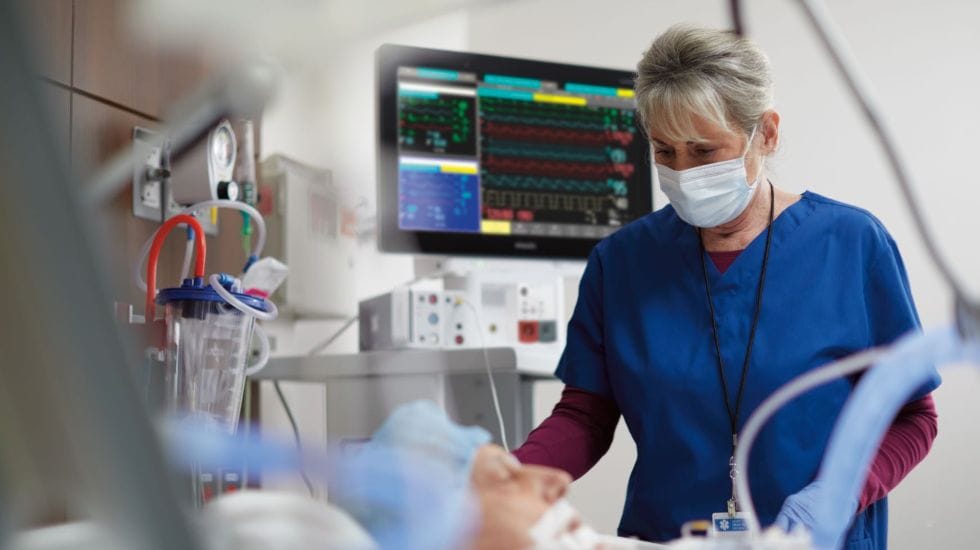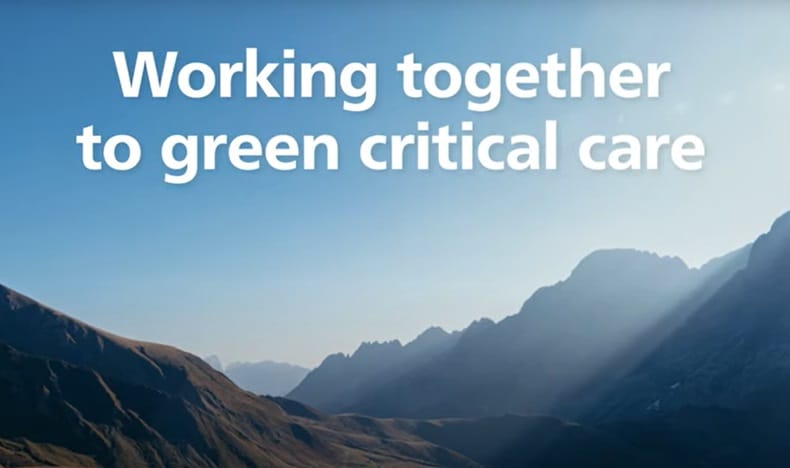Making critical care more sustainable in the NHS
By Philips editorial team ∙ Jan 01, 2023 ∙ 5 min read
The County Durham and Darlington NHS Foundation Trust (CDDFT) partnered with Philips to undergo a 360-sustainability assessment, and to reduce the environmental impact of its Intensive Care Unit.
Strategically chosen as a focus area, critical care is a high consumer of electricity and single-use items and is one of the most expensive types of care. Collaborative efforts identified opportunities to reduce the carbon footprint and material waste across patient care pathways and staff workflows.
Case study at a glance
Partner
County Durham and Darlington NHS Foundation Trust
Challenge
The Trust is part of the National Health Service in the UK, which aims to become the world’s first net zero health service by 2040. CDDFT understands that a sustainable future for the Trust and the wider NHS will be one that embraces partnerships and innovation, and identifies ways of driving the highest quality clinical care through environmental improvements.
Solution
The Trust partnered with Philips to undergo a 360-sustainability assessment of its critical care and uncover opportunities to reduce the carbon footprint and waste in critical care.
Results
A detailed report highlights key sustainability opportunity areas and recommendations for targeted improvements, which will now serve as a blueprint for further change. There is a particular focus on medical equipment, estates and facilities, clinical operations, and the supply chain.

The challenge
Healthcare’s environmental footprint is a global problem. Many organizations are recognizing that they need to take urgent steps to reduce their impact, while planning how to provide holistic care in the future. In the UK, it’s reported that the National Health Service (NHS) accounts for 4% of the UK’s carbon dioxide (CO2) emissions and is responsible for around 20 million tons of CO2 emissions annually [1,2]. It is undergoing a journey to be the world’s first net zero health service, with a target of reaching net zero by 2040 for emissions it controls directly and 2045 for emissions it can influence. But the NHS can’t do this alone, especially as 62% of emissions are identified as ‘Scope 3’ (indirect). To succeed, there must be significant collaboration across the public and private sectors, including suppliers and partners. CDDFT understands that a sustainable future for the Trust and the wider NHS will be one that embraces partnerships and innovation, and identifies ways of driving the highest quality clinical care through environmental improvements. Philips was the first private-sector organization to approach CDDFT, offer a collaborative hand, and support its aims to become an exemplary Trust for environmental sustainability in human healthcare. We share a common purpose: to enable sustainable high-quality healthcare that improves, maintains, or restores health, is affordable to all now and in the future, while minimizing negative impacts on the environment. Sustainable healthcare challenges in the UK
The solution
Trust ambitions County Durham and Darlington NHS Foundation Trust is one of the largest integrated care providers in England, employing over 7,000 members of staff and serving a population of over 650,000 people. The Trust recognizes that it has a key role to play in reducing its carbon emissions and, as an anchor institution, supporting the local community in adapting to climate change. Today, it’s still in the early stages of its sustainability journey. “Working with Philips, who also has a strong interest and footing in sustainability, has complemented our efforts and opened our eyes to other key focus areas,” said Sue Jacques, Chief Executive, County Durham and Darlington NHS Foundation Trust. “The team that we worked with are a credit to the business – amazing individuals, who were focused, hard-working and engaging, with unbounded enthusiasm.” The solution ‘Greening critical care’ is a joint response between the Trust and Philips. Through the Trust’s existing Managed Service strategic partnership in radiology, Philips suggested a holistic analysis of the existing care environment with a focus on material and waste management. The aim of the program was to identify critical opportunities to reduce carbon footprint and material waste across patient care pathways and staff workflows. Critical care was strategically chosen as a focus area as per patient, it is a high consumer of electricity and single use items and is one of the most expensive types of care. The program fosters sustainable optimization across all aspects of critical care: clinical process, supply chain, technology, and healthcare environments.
There was an early realization that we shared the same understanding about what collaboration really means as with climate change, we either all cross the line together or no one crosses it at all.
Consultants with environmental and clinical expertise from the Philips team applied a 360-degree methodology, including extensive data analysis and observation, as well as discussions with medical and administrative staff in the ICU. This took place over a six-month period. In addition, the Philips team interviewed stakeholders from areas such as clinical services (nurses, physicians, physiotherapists, rehabilitation specialists), facilities, waste and sustainability management, as well as procurement, supply chain and real estate. In partnership with staff at CDDFT, Philips consultants analyzed current state data, made on-site field visits for key CDDFT stakeholder interviews, and held shadowing and observation sessions in the areas of clinical workflow, supply chain and procurement, medical technology, and experience design. Hixson said that the team from Philips took a holistic approach. “They didn’t just come in and say, ‘let’s talk carbon’, they were open to discuss our interests too,” Hixson said. Because of the collaboration, Hixson and the Trust recommended that Philips sign the ambition statement for the Aspen Institute’s Cargo Owners for Zero Emission Vessels (coZEV), sending a signal of urgency across industries to accelerate decarbonization of the maritime value chain. “Philips was the first healthcare supplier organization to sign, and we hope it will pave the way for others,” Hixson said. The experienced Philips consultants went through an extensive fact-finding exercise, using proven data visualization tools to analyze the information, exploring the following areas:

The results
The team then produced a detailed report, highlighting key sustainability opportunity areas and recommendations for targeted improvements, which will now serve as a blueprint for further change. These were showcased at a joint workshop event, with a particular focus on medical equipment, estates and facilities, clinical operations, and supply chain. The following areas were outlined, alongside specific key performance indicators (KPIs) to measure:
Taking action
During the workshop, stakeholders from Philips and CDDFT discussed the importance of the findings and demonstrated a commitment to driving them forward. The Trust is already implementing some of the recommended initiatives, including: In addition, CDDFT has achieved over 95% compliance with the National Health Service’s net zero education module. The team is now planning to measure the impact of the interventions made.
The relationship with Philips is going to be important for the next phase of our sustainability work and it’s great to have such a trusting, productive and innovative partnership.
The report-out session included key team members along with senior management. Commitments were made to drive key changes and ensure they move forward. “It was very helpful to be doing a piece of work that was structured in a different way to what we’ve done before, and it was a real delight for the teams that were working with Philips,” Jacques said. “The relationship with Philips is going to be important for the next phase of our sustainability work and it’s great to have such a trusting, productive and innovative partnership.” “Healthcare in the UK has made progress towards becoming more sustainable and less carbon-intensive,” said Aylin Groenewoud, Senior Experience Lead Sustainability at Philips, who led the study. Philips is keen to support other Trusts in identifying critical sustainability patient and staff experience touchpoints, and improvement and optimization opportunities, to reduce carbon emissions and material waste. “Working with the team at County Durham and Darlington NHS Trust was a fantastic opportunity to not only support them with their sustainability goals, but also pilot a new proposition for Philips, which we are now excited to take to market,” Groenewoud said. Hixson, who was the planetary health lead at the Trust at the time, called the outcomes ‘enlightening.’ “We knew there were going to be areas to address, but Philips took time to undertake quantitative analysis which validated our suspicions and provided outputs we could present back to the wider Trust,” Hixson said. “For me, I believe the quality of care we provide on the unit has improved because of the work, as well as through the direct way we serve certain groups of patients. For example, by looking at patient flow and de-medicalization of patients, we are helping to ease demand on critical care by adjusting medication, removing monitoring that is no longer required and moving patients onto new pathways, in a positive way.” Results from case studies are not predictive of results in other cases. Results in other cases may vary.
References
[1] https://www.england.nhs.uk/greenernhs/national-ambition/
[2] https://www.kingsfund.org.uk/projects/time-think-differently/trends-sustainable-services
[3] https://www.ncbi.nlm.nih.gov/pmc/articles/PMC7045184/
[4] https://www.thelancet.com/pdfs/journals/lanplh/PIIS2542-5196(20)30271-0.pdf
[5] https://www.kingsfund.org.uk/publications/nhs-hospital-bed-numbers








